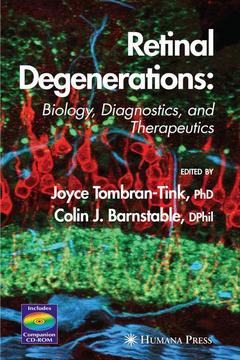Retinal Degenerations, Softcover reprint of the original 1st ed. 2007 Biology, Diagnostics, and Therapeutics Ophthalmology Research Series
Langue : Anglais

For centuries, humans have tried to explain the complex process of vision and find effective treatments for eye diseases. Perhaps the oldest surviving record of ancient ophthalmic practices is the Babylonian code of Hammurabi that over 4000 years ago, mentioned fees for eye surgery?and penalties for unsuccessful operations that led to loss of the eye. Babylonian medicine was controlled by priests who directed the work of skilled surgeons. The earliest records of Egyptian medicine date from almost the same time. The Ebers Papyrus, dating back to more than 3500 years ago is a superbly preserved document in which a section outlines a relatively advanced system of diagnosis and treatment of various ocular pathologies. The text reveals that ancient Greek and Egyptian physicians prescribed ?liver juice? for night blindness. This was obtained from roasted and crushed ox liver. We now know that their prescription contained a remarkable amount of vitamin A. It was only within the last century, however, that we have recognized the importance of vitamin A to the function of photoreceptors and visual acuity and that its deficiency can result in night blindness. Egyptian ophthalmological practices were held in high esteem in the ancient world and so were their medical institutes, called ?peri-ankh,? which existed since the first dynasty. Herodotus, the fifth century BC Greek historian, comments on the specialization of the physicians: ?Each physician treats just one disease.
Living with Retinal Degeneration.- Coping With Retinal Degeneration.- Degenerative Diseases of the Retina.- Epidemiology of Age-Related Macular Degeneration Early in the 21st Century.- Leber Congenital Amaurosis.- Macular Degeneration.- Stargardt Disease.- X-Linked Juvenile Retinoschisis.- Retinal Degeneration in Usher Syndrome.- Mouse Models of RP.- Mechanisms Underlying Retinal Degenerations.- The Impact of Diabetes on Neuronal, Glial, and Vascular Cells of the Retina.- Statins and Age-Related Maculopathy.- The Role of Drusen in Macular Degeneration and New Methods of Quantification.- RPE Lipofuscin.- Genetic Modifiers That Affect Phenotypic Expression of Retinal Diseases.- X-Linked Retinal Dystrophies and Microtubular Functions Within the Retina.- Synaptic Remodeling in Retinal Degeneration.- Developing Therapeutic Strategies for Retinal Degenerative Diseases.- On The Suppression of Photoreceptor Cell Death in Retinitis Pigmentosa.- Cell-Based Therapies to Restrict the Progress of Photoreceptor Degeneration.- Current Status of IPE Transplantation and Its Potential as a Cell-Based Therapy for Age-Related Macular Degeneration and Retinal Dystrophies.- Recent Results in Retinal Transplantation Give Hope for Restoring Vision.- Stem Cells and Retinal Transplantation.- Application of Encapsulated Cell Technology for Retinal Degenerative Diseases.- Effective Treatment for the Canine RPE65 Null Mutation, a Hereditary Retinal Dystrophy Comparable to Human Leber’s Congenital Amaurosis.- Neuroprotective Factors and Retinal Degenerations.- Carbonic Anhydrase Inhibitors as a Possible Therapy for RP17, an Autosomal Dominant Retinitis Pigmentosa Associated With the R14W Mutation, Apoptosis, and the Unfolded Protein Response.- Macular Degeneration—An Addendum.
Examines the impact of diabetes on neuronal, glial, and vascular cells of the retina Describes the role of drusen in macular degeneration and new methods for quantification Presents cell-based therapies for restricting the progress of photoreceptor degeneration Explores cutting-edge stem-cell based therapies for retinal transplantation Introduces genetic modifiers affecting phenotypic expression of retinal diseases Discusses the importance of endogenous neurotrophic factors in retinal survival
Ouvrage de 466 p.
17.8x25.4 cm
Ouvrage de 466 p.
17.8x25.4 cm
Thèmes de Retinal Degenerations :
Mots-clés :
aging; apoptosis; biology; cell; death; diabetes; diagnostics; genetics; macular degeneration; mutation; protein; receptor; retina; stem cell; stem cells
© 2024 LAVOISIER S.A.S.



